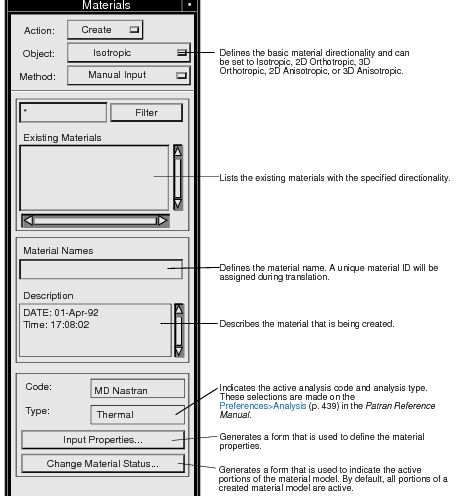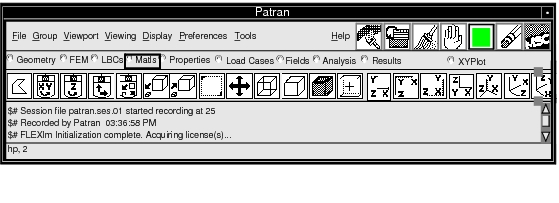XXXXXXXXXXXXXXXXXXXXXXXXXXXXXXXXXXXXXXXXXXXXXXXXXXXXXXXXXXXXXXXXXXXXXXXXXXXXXXXXXXXXXXXXXXXXXXXXXXXXXXXXXXXXXXXXXXXXXXXXXXXXXXXXXXXXXXXXXXXXXXXXXXXXXXXX''"> 3.4 Material Library
The Materials form will appear when you select Materials from the main form. The selections made on the Materials menu will determine which material form appears, and ultimately, which MD Nastran material will be created.
The following pages give an introduction to the Materials form and details of all the material property definitions supported by the Patran MD Nastran Thermal Application Preference.
Only material records that are referenced by an element property region will be translated. References to externally defined materials will result in special comments in the MD Nastran input file, e.g., materials that property values are not defined in Patran.
The Patran MD Nastran forward translator will perform material type conversions when needed. This translation applies to both constant material properties and temperature-dependent material properties.
Materials Form
This form appears when you select Materials from the main menu. The Materials form provides options for specifying MD Nastran material data.

The following table outlines the material properties for MD Nastran thermal analysis.
Object | Constitutive Model | MD Nastran Bulk Data | Input Data | Temp
Dep |
Isotropic | Solid properties | MAT4, MATT4 | Thermal Conductivity Specific Heat Density | yes yes no |
Fluid properties | MAT4, MATT4 | Thermal Conductivity Specific Heat Density Dynamic Viscosity | yes yes no yes |
Phase changes | MAT4 | Reference Enthalpy Phase Change Temperature Phase Change Temp. Range Latent Heat | no no no no |
Heat generation | MAT4, MATT4 | Heat Generation Multiplier | yes |
2D Orthotropic | Solid properties | MAT5, MATT5 | Thermal Conductivity Kx/Kr Thermal Conductivity Ky/Kz Specific Heat Density | yes yes yes no |
Heat generation | MAT5, MATT5 | Heat Generation Multiplier | yes |
3D Orthotropic | Solid properties | MAT5, MATT5 | Thermal Conductivity Kx Thermal Conductivity Ky Thermal Conductivity Kz Specific Heat Density | yes yes yes yes no |
Heat generation | MAT5, MATT5 | Heat Generation Multiplier | yes |
2D Anisotropic | Solid properties | MAT5, MATT5 | Thermal Conductivity Kxx Thermal Conductivity Kxy Thermal Conductivity Kyy Specific Heat Density | yes yes yes yes no |
Heat generation | MAT5, MATT5 | Heat Generation Multiplier | yes |
3D Anisotropic | Solid properties | MAT5, MATT5 | Thermal Conductivity Kxx Thermal Conductivity Kxy Thermal Conductivity Kxz Thermal Conductivity Kyy Thermal Conductivity Kyz Thermal Conductivity Kzz Specific Heat Density | yes yes yes yes yes yes yes no |
Heat generation | MAT5, MATT5 | Heat Generation Multiplier | yes |
Constitutive Models
The material properties for isotropic materials are divided into different categories called constitutive models, as follows:
For a single material, you only need to define the constitutive models and properties necessary for the particular analysis. For example, in a steady-state analysis of a simple solid, you need only define the thermal conductivity. The phase changes and heat generation constitutive models need to be defined only when these effects are present in the analysis.
Solid Properties
Thermal conductivities may be defined for isotropic, orthotropic, and anisotropic materials. When the 2D orthotropic material is used in an axisymmetric analysis, the conductivity Kr applies to the radial direction and the conductivity Kz is along the axis of symmetry. The conductivities may be defined as functions of temperature by creating temperature-dependent functions in the Fields application and then referencing these functions on the Materials form.
Density and specific heat define the heat capacity of the body and are needed only in transient analysis.
Fluid Properties
The dynamic viscosity is used in the calculation of the Reynolds (Re) and Prandtl (Pr) number in forced convection/advection applications and applies only to the Flow Tube element. The fluid specific heat, thermal conductivity, and density are also required for the formulation of the advective Streamwise Upwind Petrov Galerkin (SUPG) elements. This is the case even for steady-state analysis.
(3‑1)Recall

Phase Changes
To model a phase change, you need to specify the latent heat and a finite temperature range over which the phase change is to occur. You also need to specify the lower boundary of the transition temperature as well as the reference enthalpy. The reference enthalpy is defined as the enthalpy corresponding to a zero temperature if the heat capacity Cp is a constant. If the heat capacity is temperature dependent, then the enthalpy must be defined at the lowest temperature value in the tabular field.
For pure materials, the temperature range over which the phase change takes place can be quite small, whereas for solutions or alloys the range can be quite large. Numerically, the wider the range the better. It is not recommended to make this range less than a few degrees.
Heat Generation1
The heat generation multiplier allows the definition of a temperature-dependent rate of volumetric heat generation to be defined. Usually a temperature-dependent function will be defined in Fields and selected on the Materials form. The value defined by this field will multiply the rate of heat generation defined on the Applied Heat, Volumetric Generation LBC. If the heat generation is not temperature dependent, only the Volumetric Generation LBC needs to be defined.


